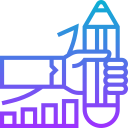Skill Stack: The Capabilities That Compound
Learn to form testable hypotheses, synthesize patterns, and design within reusable systems. When Priya mapped flows across four teams, she spotted conflicting patterns that confused users. Standardizing components cut build time and unlocked reliable user expectations across surfaces.
Skill Stack: The Capabilities That Compound
Deepen typographic hierarchy, spacing rhythms, and motion intent. Microinteractions should guide, not distract. A simple easing curve can make a flow feel trustworthy. Keep a weekly micro-crit with peers, focusing on one principle, and track improvements against usability findings.










